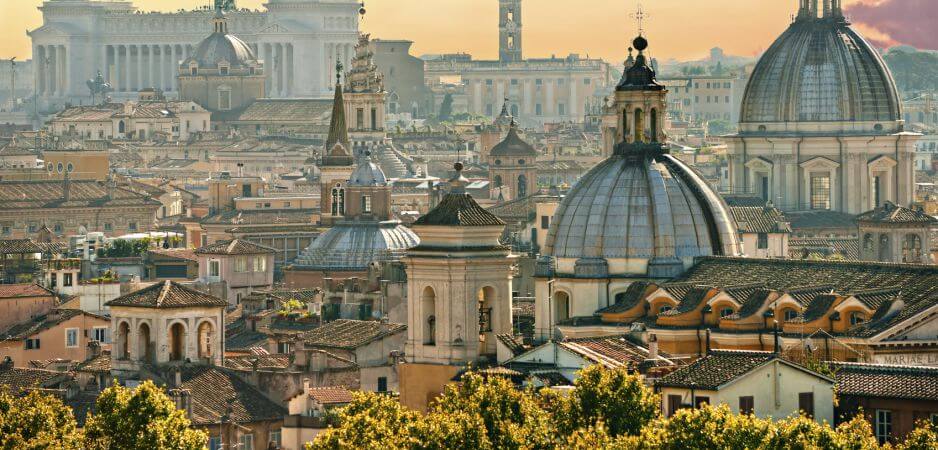In the first of a three-part series, Fasil Amdetsion looks at the evolution of Italy’s relationship with its former colonies in the Horn of Africa.
Earlier this year, Italy hosted the first ever Italy-Africa Ministerial Conference in Rome. Held at the cavernous travertine-laden Farnesina headquarters of the Ministry of Foreign Affairs, the meeting was attended by high-level delegations from over 40 African countries.
In his closing remarks, Italian Prime Minister Matteo Renzi underscored his intention of broadening political and economic ties with the African continent, by voicing his hope for a “future in which Africa is seen not as the greatest threat—as some demagogues would have it—but as the greatest opportunity.”
The conference, which is intended to be a biennial affair, and Renzi’s visits to sub-Saharan Africa (the first ever by a sitting Italian premier) reflect the Italian government’s commitment to reinvigorating the relationship.
Mutual Benefits
Italy has been late to realize the mutual benefits that can accrue from a more robust partnership with Africa. Even though it is the world’s eighth largest economy, and Africa’s sixth or seventh most significant trading partner, Italy’s postwar political engagement with the continent has been episodic, and commercial exchanges are below their potential.
Other countries have realized much sooner that regular high-level political dialogue featuring targeted discussions about trade and development could spur investment. China and India, for example, both hold triennial summits with African leaders, whereas the United States holds the biennial US-Africa Business Summit. The French arrange an annual Africa-France Summit, Japan regularly organizes the Tokyo International Conference on African Development, and Turkey has periodically spearheaded summits with continental leaders.
What accounts for Italy’s laggardness to date?
Italy’s insularity and relative economic underdevelopment explains Italian officialdom’s comparatively low level of engagement with Africa post-World War II. Political instability wrought by constant changes in government—63 since 1945—also stunted long-term strategic thinking at la Farnesina.
Moreover, at varying times and to varying degrees, Italy’s former colonial possessions—and their relationship with Rome—were beset with problems, some of their own making, others attributable to Italy. As a result, for most of the postwar period, Italy, unlike Britain or France, could not use its former colonies as a launch pad for strengthening political and business ties elsewhere on the continent.
Understanding the factors impeding closer ties between Italy and the sub-Saharan African countries with which it had historical ties requires understanding the nature of Italy’s postwar exchanges with Eritrea (an Italian colony from 1890 to 1941); Somalia (Italian Somaliland comprising most of modern-day Somalia was a colony from 1889-1941, it continued to be ruled by the Italians under a United Nations trusteeship until 1960 when, at independence, it was conjoined to British Somaliland); and Ethiopia (occupied, but never fully pacified, from 1936 to 1941).
ERITREA
The Italian community in Eritrea was mostly nestled in the picturesque capital, Asmara. Initially a settlement of a mere 150 inhabitants, Asmara was officially founded as a town when the governor of the then Ethiopian Mereb Mellash province, Ras Alula, opted to make it his new capital. When it fell under Italian rule, Asmara blossomed. In a bid to turn it into Africa’s “Little Rome,” the Italians expended significant resources to modernize the city’s infrastructure and to beautify it with Art Deco architecture for which it is renowned to this day.
The colony’s most prominent Italian businessmen made Asmara and its environs their home. These included figures like Barattolo, who got his start in the textile sector, opening a single factory employing a mere 200 workers and eventually growing his business to around 10,000 workers.
Emma Melotti was certainly the region’s most prominent female entrepreneur. After her husband’s passing, she took over his namesake brewery, and under her sapient stewardship, Melotti came to dominate the Ethiopian market through a network which enveloped even remote villages. Melotti was also available throughout the region, being sold in Sudan, Djibouti, Somalia, Yemen and Kenya.
Ethiopian-Eritrean Federation
The first snag in relations between Eritrea and the Italian community—principal propulsor of relations—emerged soon after Eritrea was re-conjoined to Ethiopia under a federal arrangement in 1952, as mandated by United Nations (UN) Resolution 390 (V). Previously Ethiopian, then colonized by the Italians, and after World War II a British protectorate, Eritrea was federated to Ethiopia upon the condition that Eritrean institutions bequeathed by the British—such as the legislature and courts—would continue to function unimpeded.
This resolution of the Eritrean issue via federation—though temporary it later turned out to be—occurred in spite of competing formulas floated by other states at the UN. Among those opposed to the federal arrangement, for instance, was Italy. Though Italy’s post-World War II government may have been post-fascist, it was not postcolonial.
Rome favored a solution where Eritrea remained an Italian colony; and barring that, advocated that Italy continue to administer Eritrea under UN trusteeship. Ultimately resigned to the fact that neither of these proposals would garner sufficient support, Italy called for Eritrean independence. Indeed, during this time, Ethiopia and Italy financially supported rival (and armed) groups—pro-union on the one hand, pro-independence on the other.
Ethiopian diplomats secured a diplomatic coup by obtaining sufficient international support for the Ethiopian-Eritrean Federation, but the same imperial government also helped sow the seeds of the two countries’ eventual separation.
In a pique of royal obstinacy and heavy-handedness, and only 10 years after consummation of the Ethiopian-Eritrean Federation, Emperor Haile Selassie, unwisely going against the counsel of some of his advisers, forcibly dissolved the federal arrangement. His decision subsumed Eritrea into the unitary Ethiopian state and gave further impetus to Eritrean agitation for secession.
The Derg
The beginnings of armed resistance, and the consequent instability in Eritrea, began to hinder Italian (and, indeed, all) commercial activity. The Eritrean Liberation Front (ELF)—a precursor to today’s governing Eritrean People’s Liberation Front—for instance, regularly engaged in extortion by levying “taxes” on agricultural land concessions run by Italians.
 Fair Observer provides you deep and diverse insights for free. Remember that we still have to pay for servers, website maintenance and much more. So, donate now to keep us free, fair and independent.
Fair Observer provides you deep and diverse insights for free. Remember that we still have to pay for servers, website maintenance and much more. So, donate now to keep us free, fair and independent.
The coming to power in 1974 of Ethiopia’s military government, the Derg, in 1974, made the business environment particularly inhospitable for Italians; most private enterprises were nationalized and expropriated. The Derg’s decision to close all foreign consulates in Eritrea, including the Italian consulates in Asmara and the port town of Massawa, further hastened the Italian exodus.
In one particular act of ruffianism, Derg functionaries went so far as to break into the then vacated Italian consulate in Asmara and temporarily occupied its premises. The final nail in the coffin of a continued Italian presence in Eritrea was the then province’s envelopment by civil war throughout the 1970s and 1980s.
ETHIOPIA
In Ethiopia, much like Eritrea, the “vanguard” of Italo-Ethiopian ties were Italian residents. The Italian community thrived due to its industriousness and ingenuity. Its prosperity, however, was also enabled by Haile Selassie’s injunction prohibiting retribution against Italians who had not committed war crimes.
Among the most successful businessmen entrepreneurs were Mario Buschi, who was involved in public works and ran a company with boats for hire on Lake Tana, source of the Blue Nile; or Mezzedimi, the Italian architect responsible for designing a number of buildings that came to dominate Addis Ababa’s postwar urban landscape, including the UN Economic Commission for Africa’s sprawling Africa Hall.
Such commercial activity occurred in spite of what were often lukewarm political ties between the two countries. Closer postwar relations between the two governments were inhibited for several reasons.
In the first instance, stalled negotiations over payment of reparations hindered the establishment of closer ties. Italy reneged on its obligation to pay Ethiopia $25 million for war damages and moral harm, as laid out in the 1947 Treaty of Peace. Indeed, at one point, the negotiating positions of both parties seemed irreconcilable. The Italian government maintained that it owed Ethiopia no money, because any moral or physical harm caused by Italy’s five-year occupation of the country was supposedly outweighed by public works the Italians had built. Ethiopia countered that Italy’s egregious war crimes warranted that it pay above and beyond the $25 million stipulated by the peace treaty.
Giuliano Cora, an Italian journalist who at the time commented on the absurdity of this diplomatic impasse, rhetorically asked: “Do we really have to compromise our situation and our future in this region for want of $25 million?” It appears that the Italian government was prepared to do so.
Ultimately, Italy secured the better bargain. Addis Ababa agreed to a lower figure of $16.3 million and the payments occurred under the guise of “technical and financial assistance” for the construction of a dam not far from the capital and a textile mill in the town of Bahir Dar. No mention was ever made of reparations.
Even with this hurdle cleared, another remained: restitution of the 1,700-year-old Axum obelisk, which the Italians had plundered during the occupation. To placate Addis Ababa, Italy offered to build a hospital or an interstate road, in exchange for the uncontested “right” to retain this concrete reminder of its colonial past. Here, too, Italy conveniently forgot that the 1947 treaty mandated the obelisk’s return.
The saga finally ended in 2005 when Italy bore the costs of surgically slicing the obelisk into three parts, so as to have it transported back to Axum in three trips aboard an Antonov plane. Ironically, it was Silvio Berlusconi’s center-right government (whose governing coalition included neo-fascists) that made amends.
Italy still retains other important wartime loot, most importantly a portion of Ethiopia’s prewar Ministry of the Pen archives that appears to be within the custody of the Italian Ministry of Foreign Affairs. This issue has been forgotten by both sides. The government of Ethiopia ought to try secure the archives’ return.
Haile Selassie’s imagination
The most curious stumbling block to closer postwar Italy-Ethiopia relations, however, was the delay by Rome in extending an official invitation to the emperor to visit Italy. The Ethiopian monarch fervently wanted to revisit the country he had last seen in 1924 as regent. His trip had been perennially postponed due to a disagreement over a number of issues, including negotiations over reparations and the Axum obelisk; as well as the impolitic decision by the Italians, at one point, of scheduling Haile Selassie’s visit for shortly after the planned visit of Somalia’s president, at a time when the two countries were at loggerheads over disputed land.
Perhaps no two countries captured Haile Selassie’s imagination as much as Italy and France. The monarch’s fondness for the French is easy to comprehend. Haile Selassie was Francophone, and after an early traditional Ethiopian church education, schooled by a Guadeloupian physician and a Francophone Ethiopian Capuchin monk. But what to make of his affection for Italy on both an emotive and psychological level?
After all, it was Italy that had unseated him, and it was in Italy that his first daughter, Princess Romanework, and two of her sons had died after having been captured by the Italians.
According to Italian historian Angelo Del Boca, Haile Selassie reputedly confided to Giulio Pascucci-Righi, the Italian ambassador accredited to Addis, in 1970:
“I owe nearly everything to Great Britain. The British gave me a place to live when I chose to go into exile, and they brought me to my homeland. All the same, as it may seem, the Ethiopian people have no love for Great Britain. Only two countries are our friends and understand us. Those countries are France and Italy. I hope that my successors will keep the faith [with regard to] this two-fold constant.”
The likelihood that the emperor’s words reflected the Ethiopian people’s state of mind after a brutal war and occupation is close to nil. His pro-Italian gestures soon after the war ended could, in theory, be attributable to a desire to play off the Italians against the British.
British forces had fought together with Ethiopian patriots to dislodge the Italians and had remained behind after Ethiopia’s liberation. It is possible that Haile Selassie wanted to guard against Britain’s accumulation of undue influence in Ethiopia, and the risk that having gained such influence, Britain would wield it to declare Ethiopia a protectorate. But the words spoken to Ambassador Pascucci-Righi were purportedly spoken in 1970, years after the threat of falling under Britain’s sway had passed.
Regardless of whether the words spoken privately to the ambassador were accurately recounted by him, clearly the emperor’s attachment was heartfelt. First, because he persisted in sending signals, at times subtle and on other occasions explicit, to the press and visiting Italian officials that he was eager to receive an invitation to visit Italy.
Enemy Country
A further example of the emperor’s sympathy for Italy occurred in the 1960s when, having dispatched a delegation to Italy, the imperial government secured a loan from a consortium of Italian banks (with the facilitation of the Italian government). The Ethiopian government submitted the loan to the senate for final approval. The Ethiopian senate, whose members included several veterans of the Italian-Ethiopian war, rejected the loan’s terms because they considered the interest rate unduly onerous.
The emperor initially responded to the senate’s recalcitrance by claiming lèse-majesté and rebuking legislators for still treating Italy as an “enemy country.” Ultimately, in relenting, the emperor resorted to what Cambridge historian Christopher Clapham has termed a familiar imperial stratagem employed by Haile Selassie in the face of insurmountable political opposition to a deal: professing ignorance as to its details. The loan was never disbursed for want of the senate’s approval.
The incident bore an uncanny resemblance to an earlier loan negotiation between Italy and Ethiopia. In 1889, Ras Makonnen (the emperor’s father and duke of Harar), visited Italy to conclude a loan agreement on behalf of his cousin, Emperor Menelik II. Upon his return to Ethiopia, Ras Makonnen was castigated by courtiers for having agreed to a loan with interest rates that were deemed usurious, several courtiers went so far as to impugn his patriotism.
Indeed, of the 235 Italian concessions existing in Somalia at independence, comprising more than 45,300 hectares of land, most were devoted to bananas. During their colonial suzerainty over Somalia, and for several decades following independence, Italy gave preferential treatment to banana imports from Somalia by imposing higher tariffs on those imported from other countries.
When Haile Selassie’s trip to Italy finally occurred, the emperor was received with all the pomp and pageantry reserved for Italy’s most illustrious postwar guests. Perhaps the most evocative scene of the trip was described by the Italian daily, Il Giorno, which wrote of the emperor, with his diminutive figure, standing erect in an open state vehicle side-by-side with Italian President Giuseppe Saragat, accompanied by a phalanx of fully-mounted cuirassiers whose horses’ hooves click-clocked on the Roman cobblestones as the pair majestically made their way to the Quirinale Palace.
In the run-up to, and after, the emperor’s 1970 visit, official Ethiopian-Italian ties were on an upswing. Following the 1974 revolution, commerce suffered another prolonged denouement; this time caused by the military government’s nationalization of private enterprises and, later, the country’s descent into an all-consuming civil war.
SOMALIA
In post-independence Somalia, as was the case in Ethiopia, some leaders harbored an affinity for Italy, which encouraged continued engagement. Somalia’s one-time minister of planning and international cooperation, Ahmed Habib Ahmed, in words that were somewhat similar in spirit to those reportedly uttered by Haile Selassie, remarked: “[Though] I studied in France, ‘my world’ is Italian; the French are distant to me.”
Several decades post independence, Italian commercial involvement in Somalia centered upon agriculture. The Italians set up cotton, sugar and banana plantations and, after 1929, the year in which worldwide cotton prices collapsed, focused mostly on bananas. Bananas eventually became Somalia’s most significant export.
Indeed, of the 235 Italian concessions existing in Somalia at independence, comprising more than 45,300 hectares of land, most were devoted to bananas. During their colonial suzerainty over Somalia, and for several decades following independence, Italy gave preferential treatment to banana imports from Somalia by imposing higher tariffs on those imported from other countries.
Italy further bolstered its political position in Somalia by tilting in its favor in territorial disputes (this policy may not have been adhered to consistently given the frequent change in governments in Rome).
Almost immediately after independence, in the early 1960s, Somalia pressed territorial claims on Ethiopian-controlled territory inhabited primarily by ethnic Somalis. It did the same with regard to lands inhabited mostly by ethnic Somalis in neighboring Kenya and Djibouti, avowedly announcing pursuit of a Greater Somalia encompassing all ethnic Somalis.
Somalia lent pressure to its irredentist claims by supporting armed militias who made frequent forays into Ethiopia, where they were pursued back into Somali territory by forces led by General Aman Andom—an Eritrean who was an interesting historical figure in his own right; in charge of Ethiopian counteroffensives against Somalia, and later, briefly, head of state after Haile Selassie was toppled, before he too suffered the same unceremonious fate.
All-Out War
In the late 1970s, Somalia and Ethiopia actually fought an all-out war over the ethnically Somali Ethiopian Ogaden province. Italy maintained an outward veneer of neutrality, but leaned toward Mogadishu, surreptitiously allowing it to purchase military helicopters, trucks and light weaponry on the Italian market. The support emanated, in part, from the fact that since Somalia had been Italy’s longest-held colony, it was treated with some affection. Beyond that, it is reasonable to surmise that Italy’s support for Somalia may have emanated, at least in part, from lingering bitterness over the Ethiopian-Eritrean Federation—a solution to the Eritrean question which Italy had strenuously opposed.
Aside from official institutional ties, for many years Somalia also benefited from another sort of linkage with Italy: the sympathy and support of the Italian Communist Party (PCI). Promotion of commercial interests and mobilization of investment in postwar Italy were not the sole province of the government, but of political parties too. The PCI, and its competitors, jockeyed for influence at home and abroad, by supporting foreign regimes they deemed to be their ideological brethren.
Following the 1969 Somali revolution, the PCI extended cultural and technical assistance and invested in the country through Italian labor unions and affiliated entities. It provided Mogadishu with expertise and machinery to help bolster the Somali construction and agricultural sectors. Italturist, the PCI’s travel and touring company, was also tasked with arranging facilitation tours for Italian tourists in Somalia.
The Italian community in Somalia thrived as a result of the good political ties between Italy and Somalia. As was the case in Ethiopia under Haile Selassie, the Italians benefited from the protection of Siad Barre, Somalia’s post-revolution strongman. Barre inveighed against any harm befalling the Italians and expressed his sympathy toward Italians on more than one occasion, such as when he declared: “I have said, and have repeated, that for us Somalis, Italians are not considered foreigners; and this is a privilege which we have not extended to any other community.”
At one point, Barre even assured the Italians that he was “no Gadaffi.” In saying so, he was communicating to the Italians that he would refrain from following in the footsteps of the Libyan leader who had nationalized the property of Italian settlers after Libya gained its independence from Italy.
But such sweet-talking aside, as Barre fell under the Soviets’ orbit and he increasingly moved his country to the left, ideology trumped his apparent affection for Italians and a spate of nationalizations followed. The local branches of the Banca di Roma and Banca di Napoli, multiple insurance firms and AGIP—the precursor to today’s oil conglomerate, ENI—were among the Italian firms affected.
Though some firms and small factories were spared, the damage was done. Italian companies and most of their expatriate personnel left the country, never to return. Once Somalia spiraled into civil war, even the small Italian community that had faithfully remained behind returned to Italy.
Italy’s engagement with countries in the Horn of Africa was peripatetic. In Ethiopia, Africa’s second most populous country, relations were frequently rocky. Disputes arose over Eritrea and the implementation of commitments undertaken by Italy at the end of World War II by signing the 1947 Treaty of Peace; more generally, it appears that for several decades Italy struggled to come to terms with the fact that the colonial era had ended.
Italy’s focus on other geopolitical priorities, Ethiopia and Somalia’s adoption of economic policies that were inimical to an Italian presence, and their enmeshment in civil wars also minimized Italy’s engagement with the Horn and, by extension, other African countries.
The views expressed in this article are the author’s own and do not necessarily reflect Fair Observer’s editorial policy.
Photo Credit: Luciano Mortula
Support Fair Observer
We rely on your support for our independence, diversity and quality.
For more than 10 years, Fair Observer has been free, fair and independent. No billionaire owns us, no advertisers control us. We are a reader-supported nonprofit. Unlike many other publications, we keep our content free for readers regardless of where they live or whether they can afford to pay. We have no paywalls and no ads.
In the post-truth era of fake news, echo chambers and filter bubbles, we publish a plurality of perspectives from around the world. Anyone can publish with us, but everyone goes through a rigorous editorial process. So, you get fact-checked, well-reasoned content instead of noise.
We publish 2,500+ voices from 90+ countries. We also conduct education and training programs
on subjects ranging from digital media and journalism to writing and critical thinking. This
doesn’t come cheap. Servers, editors, trainers and web developers cost
money.
Please consider supporting us on a regular basis as a recurring donor or a
sustaining member.
Will you support FO’s journalism?
We rely on your support for our independence, diversity and quality.






